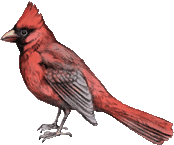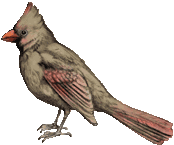|
 
Cardinalis cardinalis
Northern Cardinal, Christmas Bird
--------------------------------------------------------------------------------
Classification
Kingdom: Animalia
Phylum: Chordata
Species: Cardinalis cardinalis
Geographic Range
Nearctic: The cardinal has expanded its range considerably from 1886. At first, it was rarely seen north of the
Ohio River, but less than one hundred years later it would reach southern Ontario and the southern part of the
Hudson River. It now extends over much of North America.
Physical Characteristics
Medium-sized (22 cm length), males bright red except for black facial mask; females buffy brown or buffy olive,
tinged reddish, lack black mask (but parts of face may be dark). Thick, conical bill. Both sexes have a distinctive
crest on the top of their heads.
Food Habits
About 90% of the Cardinal's food consists of weed seeds, grains, insects, fruits, and sunflower seeds. They prefer
seeds that are easily husked. Cardinals are less selective during winter in the colder climates. According to one
observer (Searles, 1989), a cardinal was seen on a cold snowy day to feed on a dead Black-capped Chickadee.
Reproduction
They usually raise two broods a year. Early nests are made in March, then the second brood is late May to July.
The second nest is often parasitized by the Brown-headed cowbird. The nests are usually found in dense bushes.
The female lays about four white to greenish eggs that average about one inch in length and one-half inch in diameter.
They take about twelve days to hatch.
Behavior
The cardinal is not migratory. They mate, the brightly colored red male with the more yellowish tinted female,
to produce a broad similar to the female while young. The male tends to be more aggressive until it is time to
mate. Then the male attracts the female with one of a series of calls, and be feeding sunflower seeds to female.
Both sexes have a crest, which is raised at any sign of danger. The cardinal also has a pleasent voice; the chirps
in succession are often rapid and sound like cheer-cheer-cheer and whoit-whoit-whoit.
Habitat
The cardinal has a preference for the edges of woods, hedgerows, and vegetation around houses. This may be in part
why they have proliferated so well (not to mention the fact that many people encourage them by putting out sunflower
seeds). They prefer to make their nests in fairly dense thickets.
Biomes: temperate forest & rainforest, temperate grassland, mountains
Economic Importance for Humans
Positive
Its economic importance comes in the fact that it eats insects (pests such as boll weevils, cutworms, and caterpillars),
disperses seeds, and is admired by many as an attractive song bird.
Conservation
Status: no special status
There are no real efforts underway to conserve this bird. It seems to do quite well, so far, alongside humans in
the urban environment.
Other Comments
The cardinal is a great bird to admire year round. It actually often shows its best when in the dead of winter,
when it doesn't seem like there is any life left in the world until a bright red cardinal lands in a snow covered
tree. The color contrast of the brilliant red along with the dark grey twigs and fresh white snow really is a high
point during the winter months. It is also nice to hear a pair calling to each other in late winter or early spring.
|